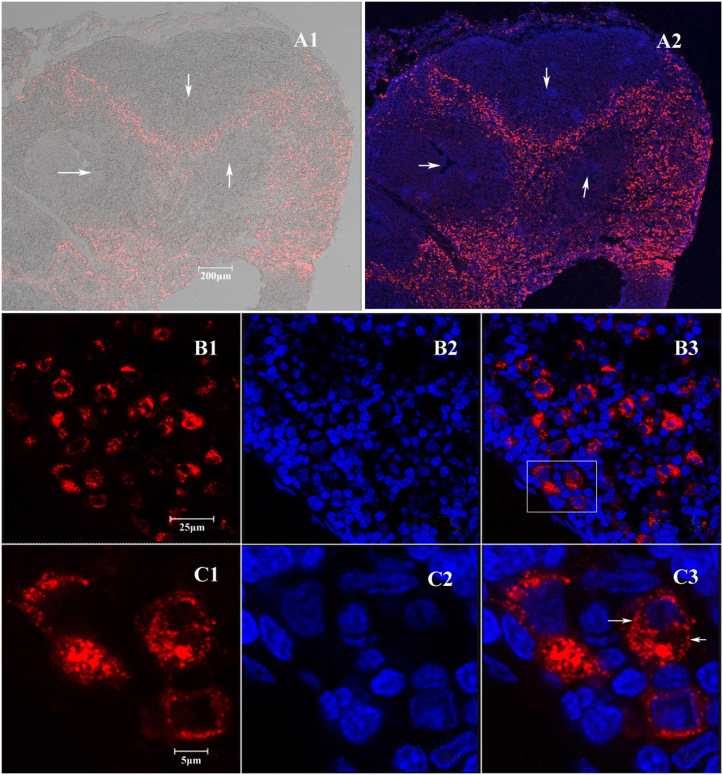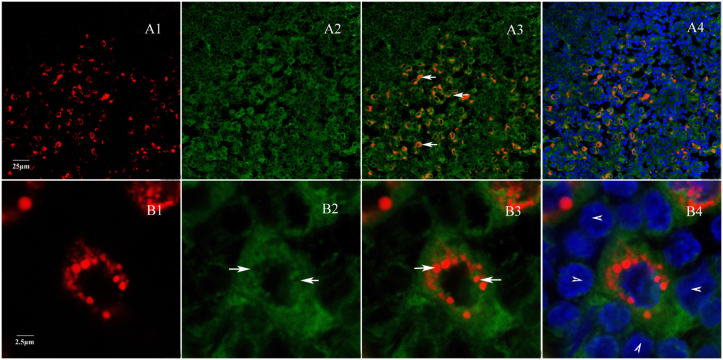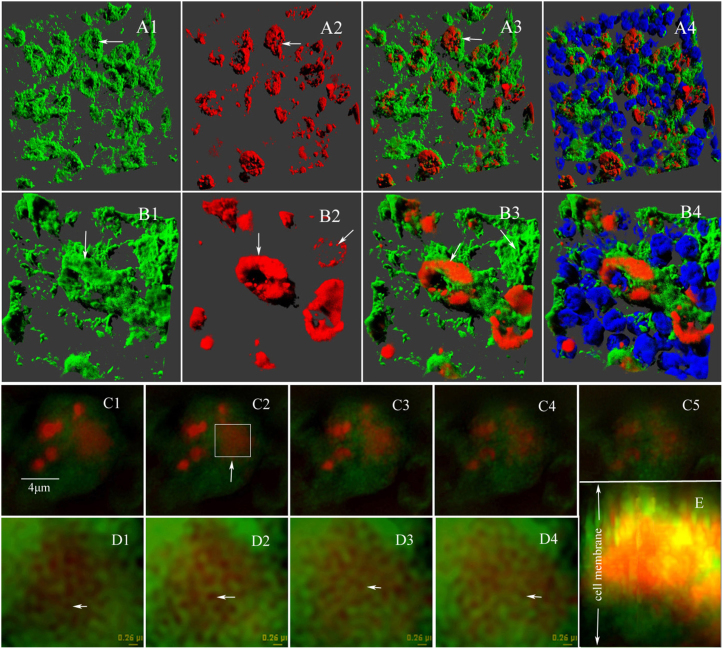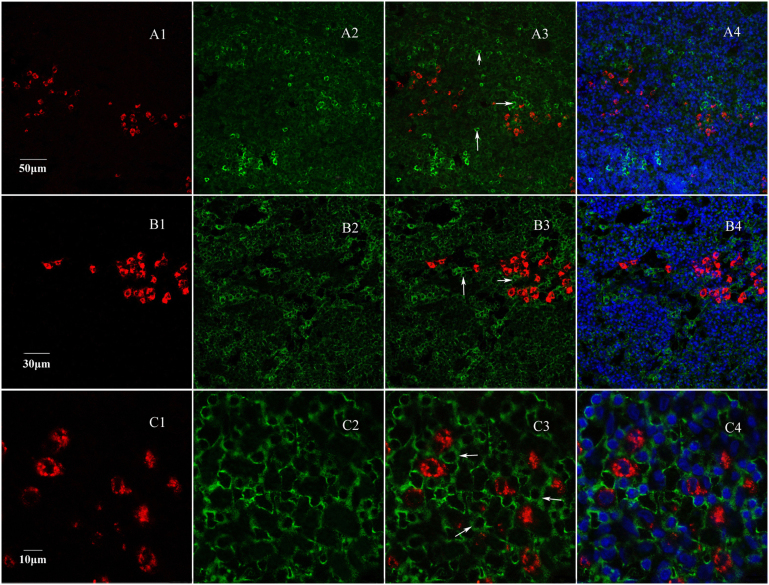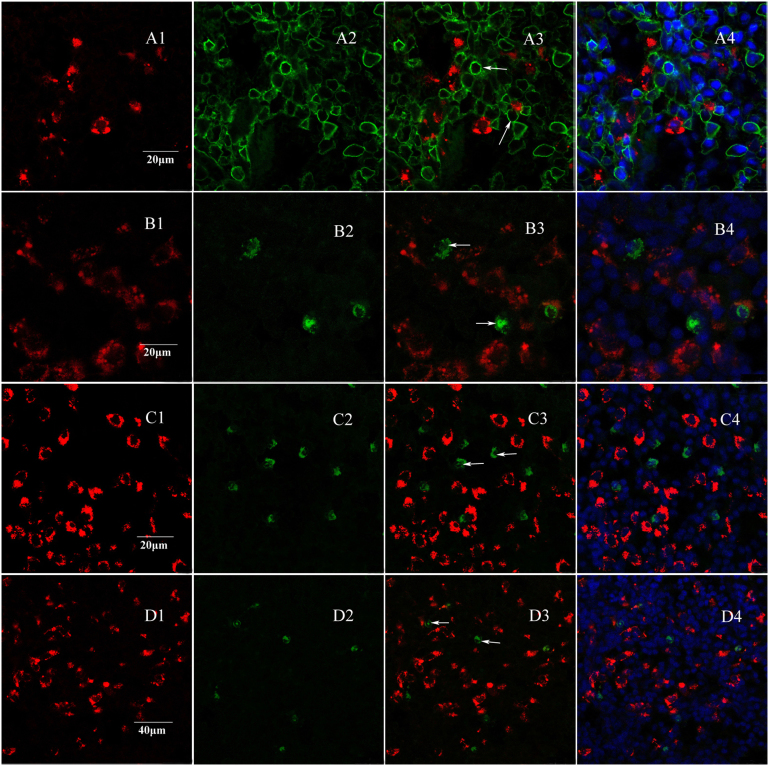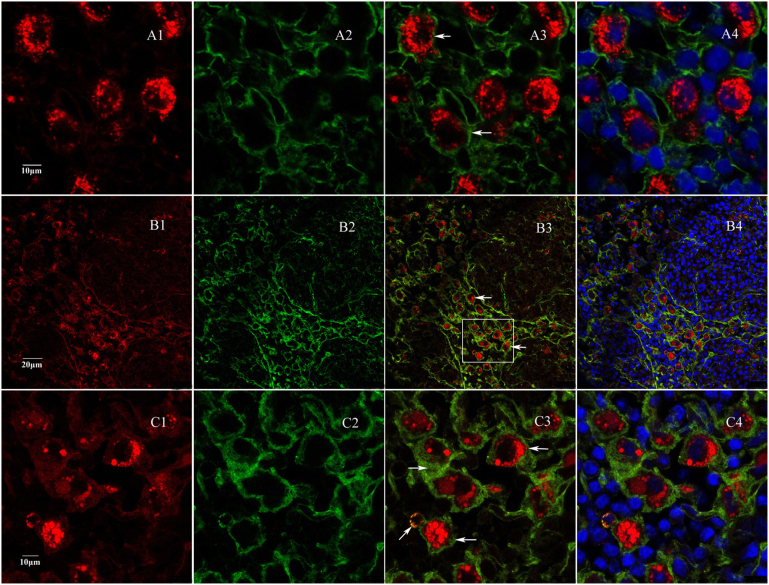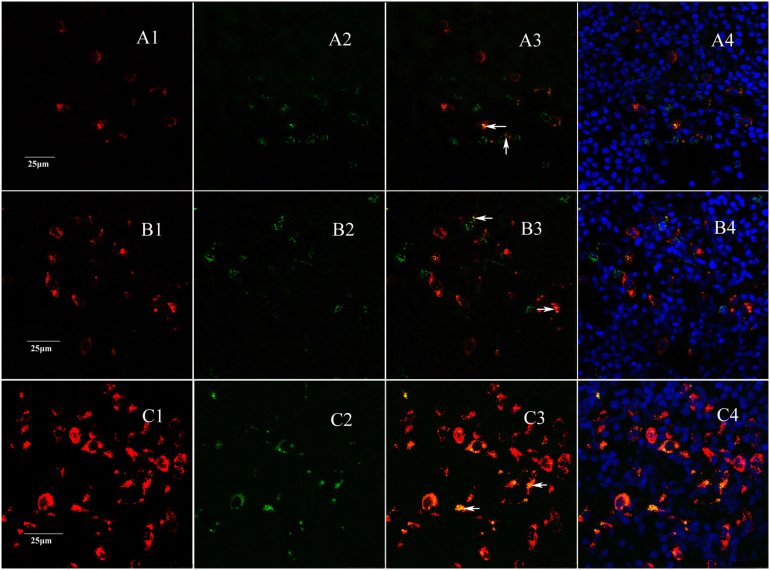Abstract
Up to now, the ‘hardwired’ neural pathway of the neuro-immune regulation is not fully understood. Here we reported a new neural pathway which links sympathetic nerves with immune cells of the lymphoid tissues. Our results demonstrated that nerve fibers derived from superior cervical ganglion directly targeted only S100+ cells in the cervical lymph nodes. Moreover, we found co-expression of neurotransmitters such as norepinephrine, vasoactive intestinal polypeptide and neuropeptide Y in the postganglionic sympathetic nerve endings that innervate S100+ cells. Our findings suggested that S100+ cells serve as a neuro-immune cross-talker in lymph organs that may play a significant role in transmitting signals of nervous cells to targeted immune cells. The new findings provide better understanding of the cross-talk mechanism between the nervous system and the immune system.
Increasing amounts of evidence showed that the communication between nervous and immune system is essential for the modification of immunological function1,2. There are two pathways involved in this two-system cross-talk: the hypothalamic-pituitary-adrenal (HPA) axis and the sympathetic nervous system (SNS)3,4. The SNS has been previously shown to be involved in neuro-immuno-modulation in addition to the HPA axis. Especially, anatomical and cellular studies have revealed the origin and distribution of sympathetic nerves that supply lymphoid tissues, and shown the expression of neurotransmitters and neuropeptide receptors on immunocompetent cells5,6. However, the functional link between sympathetic nerve endings and immune cells is not fully understood. The mechanism underlying signal transmission from the central nerve system (CNS) to immune cells is also unclear. Thus, this study was to investigate and map the neuro-immunal pathway between nerve fibers and their target cells using Fluoro-Ruby anterograde tracking of sympathetic nerve endings, immunofluorescence labeling and three-dimension reconstruction analysis. Our results provided compelling morphological evidence for better understanding of the ‘hardwired’ neural pathways of the neuro-immune regulation.
Results
We performed the anterograde tracking for sympathetic nerve (SN) fibers which innervate cervical lymph nodes in Sprague-Dawley (SD) rat using Fluoro-Ruby (FR) (Supplementary Fig. 1). On 14 days after one side of the superior cervical ganglion (SCG) was injected with FR, the frozen sections from ipsilateral cervical lymph nodes was examined with laser scanning confocal microscopy. The micrographs showed that most SN fibers to be traced were found within the cortex, paracortex and medulla of lymph nodes, where lymphocytes reside, recognize antigen, and activate, but in the nodular regions and germinal centers were sparse (Fig. 1-A). Interestingly, all the FR-labeled SN endings appeared to directly target one particular population of cells in lymph nodes (Fig. 1-B and 1-C). The FR-targeted cells were large in size and mononucleated with light nuclear density in DAPI staining (Fig. 1-B and 1-C). In order to prove the FR labelings of SN fibers resulting from axonal transport rather than simply free diffusion, we injected 1 μl of 30% FR into the location where the SCG was after SC ganglionectomy. Results showed that FR signals distributed irregularly in the diffusion between cells (Supplementary Fig. 2), but not surrounded the nucleus of particular cells in the lymph node as experimental group shown in Fig. 1. Moreover, we also performed retrograde tracing of sympathetic neurons in SCG by injecting Fluoro-Gold (FG) to cervical lymph nodes. The results showed FG signals displaying in neurons of SCG, confirming connection between SCG and the adjacent lymph nodes (Supplementary Fig. 3).
Figure 1. Distribution of FR-labeled sympathetic nerve fibers in cervical lymph nodes.
One side of superior cervical ganglion (SCG) was injected with 1 μl of 30% FR. On day 14 after injection, the ipsilateral cervical lymph nodes were moved, fixed and embedded; the frozen sections (15–25 μm) cut in cross-section were then examined. (A) Contrast (A1) and fluorescence microscopy (A2) revealed that most sympathetic fibers with FR stain (red) appeared within the cortex, paracortex and medulla of the lymph node, but scarcely in the nodular regions and germinal centers (arrows; 100× magnification). (B) Amplified micrograph displayed that FR-labeled nerve endings surrounded some cells in the lymph node (400× Magnification). FR-traced nerve endings (B1); DAPI-labeled nuclei (B2); merged image (B3). (C) Fluorescence images in the area highlighted in B3 were shown on an enlarged scale (C1–C3).
To ascertain the relationship between the SN and the targeted cells in lymph nodes, we labeled the plasma-membrane with fluorescent dye DiO for the lymph node of labeled nerve fibers. Similarly, the results showed that all FR-labeled signals targeted only one type of cells in the lymph node (Fig. 2–A3,A4), and fiber terminal are wrapped by plasma membrane of targeted cell (Fig. 2-B2, B3). Furthermore, the SN nerve-targeted cell was surrounded by several small cells (presumably lymphocytes) (Fig. 2-B4). In order to define the precise structural relationship between the cell membrane of the targeted cell and SN fiber endings, we performed three-dimensional reconstructions and high-resolution SIM fluorescence microscopic image analyses. Our results further confirmed a structural mosaic between SN endings and the membrane of the innervated cell (Fig. 3-A, B). Partially enlarged micrographs showed that 0.1–0.2 μm of FR-labeled nerve endings were embedded in the cell membrane of the innervated cell (Fig. 3-C,D and E; Supplementary movie 1 and 2). The connection of SN endings with the targeted cells in lymph nodes appeared to be similar to the classic synaptic contact between neurons and neurons, or neuromuscular junctions. To explore the possible existence of synaptic contact in lymph node, we examined the ultrastructure of a lymph node via a Philips CM-10 transmission electron microscope. The electron micrograph clearly showed that the presence of unmyelinated axons was adjacent to the innervated cells (Supplementary Fig. 4-A, B). Moreover, synaptic vesicles, mitochondria and smooth endoplasmic reticulum could be seen in a denuded axon (Supplementary Fig. 4-C, D), providing supportive evidence for the existence of synaptic structure between nerve endings and the targeted cells.
Figure 2. Relationship of labeled sympathetic nerve endings and innervated cells.
A plasma membrane dye, DiO, was used to stain the histological section of the lymph nodes labeled with FR and was then examined with confocal microscopy (TCS SP5, Lecia). Micrographs showed that FR-labeled nerve endings (red) landed on the surface of certain cells in lymph nodes (A, arrows). These cells are large in size, mononucleated with light nuclear density (DAPI staining). (B) Nerve endings wrapped around the targeted cell (arrows in B2 and B3) on an enlarged scale. The innervated cells were surrounded by lymphocytes (arrow heads in B4). A1 and B1, FR-labeled sympathetic nerve fibers endings; A2 and B2, Dio-labeled cell membranes; A3 and B3, merged images of FR and Dio from A1-A2 and B1-B2, respectively; A4 and B4, merged images of A1-3 and B1-3, respectively.
Figure 3. Three-dimensional reconstruction and high-resolution SIM observation of labeled-nerve endings and innervated cells.
(A, B) 3D reconstruction clearly showed that the labeled nerve endings (red) land on the cell membrane (green) of innervated cells (B, high magnification). (C) A series of single-cells images (0.4 μm) acquired by Z-stack scanning from high-resolution SIM (Total internal reflection fluorescence 100×1.49 NA oil immersion, Nikon) revealed a mosaic structure of nerve endings with the membrane of the innervated cell. (D) Enlargement of the image in the area indicated in C2. The enlargedimages clearly showed 0.1–0.2 μm of labeled nerve endings in the cell membrane of the innervated cell. (E) 3D reconstruction of a series of images (0.4 μm) acquired by Z-stack scanning with high-resolution SIM.
To identify the type of cells targeted by FR-labeled nerve endings, we performed immunofluoresence staining of specific membrane antigens on the FR-traced lymph node. The results showed that these targeted cells did not express specific differentiation antigens of T cells (CD3), B cells (CD22), or macrophages (CD14) (Fig. 4-A, 4-B and 4-C, respectively). Furthermore, these targeted cells did not express surface markers for dendritic cells (DCs) or plasma cells, such as the class II MHC, CD11c, CD103, and CD138 (Fig. 5-A, 5-B, 5-C and 5-D, respectively). By contrast, we found that the FR-labeled nerve innervating cells expressed S100 protein, thereby being S100-positive cells (Fig. 6-A). We then examined whether the contact between FR-labeled nerve fibers and their targeted cells was synaptic using fluorescence immunohistochemistry of synaptophysin (SYP). The micrographs demonstrated that all innervated cells were positive to SYP staining (Fig. 6B, C). The data strongly suggested that the contact between SN endings and S100+ cells is a synaptic connection.
Figure 4. Fluorescence immunocytochemistry for CD3, CD22 and CD14 with slice labeled by FR.
Red fluorescence (A1,B1,C1) is labeled nerve fibers, and green fluorescence (A2,B2,C2) is CD3+,CD22+and CD14+cells. A3, B3 and C3 are respectively merged images from CD3+ ,CD22+ and CD14+ cells and FR-labeled nerve fibers. The merged images showed that labeled nerve fibers were not around CD3+, CD22+ and CD14+ cells (A3, B3, C3 and A4, B4, C4). This immunofluorescence results demonstrated that the nerve fibers from superior cervical ganglion do not target T cells, B cells and macrophages.
Figure 5. Fluorescence immunocytochemistry for MHCII, CD11c, CD103 and CD138 with slice labeled by FR.
Red fluorescence (A1, B1, C1, D1) is labeled nerve fibers, and green fluorescence (A2, B2, C2, D2) is MHCII+, CD11c+, CD103+ and CD138+ cells. A3, B3, C3 and D3 are respectively merged images from MHCII+, CD11c+, CD103+ and CD138+ cells and FR-labeled nerve fibers. The merged images showed that labeled nerve fibers were not around MHCII+, CD11c+, CD103+ and CD138+ cells (A3, B3, C3, D3 and A4, B4, C4, D4). This immunofluorescence results demonstrated that the nerve fibers from superior cervical ganglion also do not target dendritic cells and plasma cells.
Figure 6. Fluorescence immunocytochemistry of S100 protein and SYP protein.
(A) Immunocytochemistry of S100 showed that cells targeted by FR-labeled nerve endings were S100 protein positive (green, arrows). (B) SYP staining showed that FR-labeled nerve endings were completely overlapped with SYP proteins (green, arrows), indicating that labeled nerve endings expressed SYP proteins. (C) Enlarged images in the area indicated in B4. A1, B1 and C1, FR labeled sympathetic nerve fibers; A2, S100 staining; B2 and C2, SYP staining; A3, B3 and C3, merged images of A1-2, B1-2 and C1-2, respectively; A4, B4 and C4, merged images of A1-2-3, B1-2-3 and C1-2-3, respectively.
To examine which kind of neuropeptides were in FR-labeled nerve fibers, we performed immunofluorescence staining of vasoactive intestinal polypeptide (VIP), neuropeptide Y and tyrosine hydroxylase. The results showed that these neuropeptides were co-existed in the FR-labeled nerve fibers (Fig. 7-A, 7-B and 7-C, respectively). These findings suggested that neurotransmitters such asTH, NPY and VIP are involved in transmitting signals of the nerve fibers projected from SCG to S100+cells in cervical lymph nodes.
Figure 7. Fluorescence immunocytochemistry for NPY, VIP and TH with slice labeled by FR.
Red fluorescence (A1, B1, C1) is labeled nerve fibers, and green fluorescence (A2, B2, C2) is positive NPY, VIP and TH fibers. A3, B3 and C3 are respectively merged images from NPY+, VIP+ and TH+ fibers. The merged images showed that some labeled nerve endings profiles completely overlap with positive NPY ,VIP and TH fibers. This immunofluorescence results demonstrated that labeled nerve endings profiles mostly co-express NPY , VIP and TH (arrows in A3, B3, C3).
Discussion
Growing evidence of functional contacts of nerves with immune cells and tissues challenges the established view of neuro–immune regulation via circulating hormonal and cytokine signals alone7,8. A direct neural involvement in the modification of immunological function indicates that ‘hardwired’ neural pathways are widespread and important, although homeostasis undoubtedly involves the cooperative interaction of various systems in vivo. These studies have demonstrated the importance of ‘hardwired’ neural pathways, but the direct contact between nerve fibers and immune cells remains unclear. Our study demonstrated for the first time that the nerve fibers derived from SCG targeted only S100+ cells in the adjacent cervical lymph nodes. This is an unexpected result. It is very necessary to know the credibility of this result. One natural question on this result is whether the FR signal carried to the cervical lymph node is entirely due to phagocytosed and free diffusion dye. In order to prove that the FR signal results from axonal transport rather than simply phagocytosed and free diffusion, we have done controlling experiment. The results showed that Fluoro-Ruby distributes irregularly through diffusion between cells (Supplementary Fig. 2), but the FR signal of the anterograde tracking is a regular distribution as shown in Fig. 1-B and 1-C. Another natural question is whether the FR signal is colocalized with the targeted S100+cells. S100 protein is one of the members of EF-hand type Ca2+-binding protein family and is involved in a variety of cellular processes such as cell-cycle regulation and differentiation9,10. S100 protein is an immunohistochemical marker for interdigitating reticular cells (IRC), a subset of dendritic cells, in lymphoid tissues11,12. In order to exclude the possibility of the dendritic cell-associated S100 protein, we have done variety of anti-DC antibody (MHCII, CD11c, CD103 and CD83) expression.Our experimental results show that all FR-labeled nerve endings finally were shown to directly target only S100 cells, which were not express other DC markers (MHCII, CD11c, CD103 and CD83). This evidence strongly suggests that S100+ cells are the neuro-immune cross-talker in lymph organs and play a very pivotal role in the neuro-immune cross-talk mechanism. S100+ cells might be considered as a bridge between nervous system and immunocytes, which is a conveying signals transmitted from nervous system. This pattern of the contact between nerve fibers and innervated cells in lymph nodes was rarely exposed in the literature13. Whether these cells are IRC or a new type of cells remains unclear and requires further investigations.
To explore the possible existence of synaptic contact in SN endings with the targeted cells in lymph nodes, we examined the ultrastructure of a lymph node via a Philips CM-10 transmission electron microscope. The synaptic vesicles, mitochondria and smooth endoplasmic reticulum could be seen in a denuded axon. Current EM data cannot completely prove a synaptic connection between SN endings and targeted S100+ cells. More detailed immune electron microscopy analysis is needed for further study, but this result does not affect to understand that S100+ cells are cross-talker between the nervous system and the immune system. The connected form of SN endings with the targeted cells, synapses or non- Synapses structure, also needs more further research.Several molecular markers have been used to detect different types of nerve fiber. It has been demonstrated that neurotransmitters of different nerve fiber types, such as norepinephrine, neuropeptide Y (NPY), substance P, vasoactive intestinal peptide (VIP), endogenous opioids, and others modulate immune cells via specific receptors expressed on the cell surface14,15. These neurotransmitters undoubtedly play an important role in immunomodulating as functional receptors are present on immune cells. At current stage, we know that receptors for neurotransmitters are not uniformly expressed on all immune cells under any condition and it is also dependent on specific microenvironment16,17. Although the mechanism of cross-talking between immune and nervous systems is not well understood, it has been increasingly accepted that there is very strong interaction between cells of the nervous and immune systems18,19. Our results also confirmed that neuropeptides TH, NPY and VIP were co-existed in the FR-labeled nerve fibers. These suggested that the neurotransmitters involved in transmitting signals between nerve fibers projected from SCG and S100+cells in cervical lymph nodes.
In summary, we for the first time provided the anatomical evidence to reveal a novel cross-talk pathway between CNS and immune cells. As a neuro-immune cross-talker, S100+ cells in lymph organs may play a critical role in the signal transmission from CNS to immune cells and vice versa. The targeted S100 cells in lymph organs may be a new type of cell populations. The signal transmission from CNS to immune cells is a synaptic interaction, through release of neurotransmitters such as TH, VIP and NPY. More studies are required to disclose the cross-talk mechanism and to further delineate the signals transduction from CNS to S100+ cells and to immune cells.
Methods
Animals and reagents
Sprague-Dawley rats (250–280 g) were purchased from the Experimental Animal Center of Suzhou University (Suzhou, China). The experimental protocol was approved by the Ethics Committee of Medical College, Suzhou University.The reagents used included: Fluoro-Ruby (FR, Fluorochrom, Inc., USA); primary antibodies against CD14, CD3, CD22, CD11c, MHCII, CD83, CD103, CD138, s100, Synapsin, TH, NPY and VIP from Boster Biotech (Wuhan, China) and secondary antibodies (FITC-IgG; Vector Laboratories, Inc., Burlingame, CA).
Tracer application
Ten male SD rats were used to study interconnection between SN endings and adjacent lymph nodes,Rats were anesthetized with pentobarbital sodium (20 mg/kg, i.p.); then a total volume of 1 μl of 30% Fluoro-Ruby (FR, Fluorochrom, Inc., USA) in distilled water was injected into the SCG using a microsyringe with a removable injection needle (24 gauge, Hamilton, Co., USA). After survival for 14 days, the rats were anesthetized again with pentobarbital sodium (20 mg/kg), followed by transvascular perfusion with 4% paraformaldehyde. The ipsilateral cervical lymph nodes were removed, fixed and cryoprotected. Frozen sections (15–25 μm) were cut in cross-section on a frozen microtome, picked up on gelatin-coated glass slides and examined under confocal microscope.
Tissue processing for electron microscopy
Tissues were fixed by vascular perfusion with 2.5% glutaraldehyde in 0.1 M phosphate buffer solution (PBS, pH 7.4) at a pressure of 120 mmHg. Prior to perfusion, rats were anesthetized with pentobarbital sodium (20 mg/kg). Samples from cervical lymph nodes were embedded in Epon 812 (Fluka, Buchs, Switzerland). For transmission electron microscopy, 50 nm samples were stained with uranyl acetate and lead citrate and examined under a Philips CM-10 transmission electron microscope (TCS SP5, Lecia).
Immunohistochemical staining for CD3, CD14, CD22, CD11c, MHCII, CD103, CD138, S100, TH, NPY and VIP
For immunofluorescence staining, sections obtained from antegrade FR-labeling were rinsed thoroughly in 0.1 PBS, incubated at room temperature for 30 min in 10% normal goat serum and then incubated at 4°C overnight with primary antibodies against CD3, CD14, CD22, S100, CD11c, MHCII,CD103, CD138, NPY and VIP diluted in PBS (1:100–1:500). On the next day, sections were rinsed three times in 0.1 PBS and then incubated in the fluorochrome-conjugated secondary antibodies (FITC-IgG; Vector Laboratories, Inc., Burlingame, CA) diluted in buffer (1:600) for 60 min. After rinsed thoroughly in buffer, counterstained with DAPI and rinsed three times in buffer, sections were mounted and photographed under a confocal microscope. We used DIO (3, 3′-dioctadecyloxacarbocyanine perchlorate) to stain the cell membrane.
Author Contributions
K.Y.W. designed and supervised the whole study performed some experiments, analyzed the data, and prepared the manuscript. J.Y.H., C.F.Z.H., P.P.Z.H. and Q.ZH. contributed equally to perform the majority of the anterograde labeling, immunohistochemistrical experiments and three-dimensional reconstruction. Q.F. participated in image processing, data analysis and prepared the manuscript. Y.M.L., Z.S.Z.H.; M.C.W., W.J.L. and G.Y. contributed to perform electron-microscopy; N.D., J.L., L.C., Y.L.Z.H., R.L.Y., L.L.D. and J.F. performed part of experiments; X.C.W., J.L. and B.M. participated in image processing. All authors discussed the results, provided comments and reviewed the manuscript.
Supplementary Material
Movie 1:The three-dimensional reconstructions of the labeled nerve fibers by FR and cell membrane staining
Movie 2: This is a partial enlarged film from movie 1
Supplementary figure
Acknowledgments
The authors would like to thank Drs. SJ Liu, University of Arkansas for Medical Sciences and B Hu, University of Science and Technology of China, for critical reading of this manuscript, Drs. AP Zhao, University of Maryland School of Medicine, XM Gao, ZJ Gu and YH Qiou, Medical College of Soochow University,for give some good advice in our experiment. The authors also like to acknowledge Nikon Image Center ( Shanghai and Chansn Instrument Co. LTD, China) for providing the Ti-E N-SIM Structured Illumination Super Resolution Microscope System, and Jiangsu Xianhaitian International Trading Co. LTD for providing Lecia (TCS SP5) Laser Scanning Confocal Microscope.This work was supported by the Research Foundation of Medicine Progress of China (No. EE134519), Ministry of Health of China grant LW201006 and Department of Scientific and Technological of Jiangsu Province grant SBE201077641 to Qiang Fu.
References
- Hori T., Katafuchi T., Take S., Shimizu N. & Niijima A. the autonomic nervous system as a communication channel between the brain and the immune system. Neuroimmunomodulation. 2, 203–215 (1995). [DOI] [PubMed] [Google Scholar]
- Elenkov I. J., Wilder Ronald L., Chrousos George P. & Sylvester Vizi E. The sympathetic nerve-an integrative interface between two supersystems: the brain and the immune system. Pharmacological Rev. 52, 595–638 (2000). [PubMed] [Google Scholar]
- Torpy D. J., Papanicolaou D. A., Lotsikas A. J., Wilder R. L., Chrousos G. P. & Pillemer S. R. Responses of the sympathetic nervous system and the hypothalamic–pituitary–adrenal axis to interleukin-6: A pilot study in fibromyalgia. Arthritis and Rheumatism 43, 872–880 (2000). [DOI] [PubMed] [Google Scholar]
- Kohm A. P. & Sanders V. M. Norepinephrine: a messenger from the brain to the immune system. Immunol. Today 21, 539–542 (2000). [DOI] [PubMed] [Google Scholar]
- Felten D. L., Felten S. Y., Carlson S. L., Olschowka J. A. & Livnat S. Noradrenergic and peptidergic innervation of lymphoid tissue. J. Immunol 135, 755s–765s (1985). [PubMed] [Google Scholar]
- Kelley S. M., Suzanne Y. F., David L. F., Cheryl A. H. & Shmuel L. Sympathetic nervous system modulation of the immune system. II. Induction of lymphocyte proliferation and migration in vivo by chemical sympathectomy. Journal of Neuroimmunology 49, 67–75 (1994). [DOI] [PubMed] [Google Scholar]
- James E., Downing G. & Jaleel A. Miyan. Neural immunoregulation: emerging roles for nerves in immune homeostasis and disease. Immunol. Today 21, 281–289 (2000) [DOI] [PubMed] [Google Scholar]
- Nance D. M. & Sanders V. M. Autonomic Innervation and Regulation of the Immune System. Brain Behav. Immun. 21, 736–745 (2007). [DOI] [PMC free article] [PubMed] [Google Scholar]
- Donato R. S100: a multigenic family of calcium-modulated proteins of the EF-hand type with intracellular and extracellular functional roles. Int J Biochem Cell Boil. 33, 637–668 (2001). [DOI] [PubMed] [Google Scholar]
- Kahn H. J., Marks A., Thom H. & Baumal R. role of antibody to S100 protein in diagnostic pathology. Am J Clin Pathol. 79, 341–347 (1983). [DOI] [PubMed] [Google Scholar]
- Takahashi K., Isobe T., Ohtsuki Y., Sonobe H., Takeda I. & Akagi T. Immunohistochemical localization and distribution of S-100 proteins in the human lymphoreticular system. Am J. Pathol. 116, 497–503 (1984). [PMC free article] [PubMed] [Google Scholar]
- Mesquita R. A., de Arauio V. C., Paes R. A., Nunes F. D. & de Souza S. C. Immunohistochemical analysis for CD21, CD35, Caldesmon and S100 protein on dendritic cells types in oral lymphomas. J Appl Oral Sci. 17, 248–253 (2009). [DOI] [PMC free article] [PubMed] [Google Scholar]
- Felten S. Y. & Olschowka J. Noradrenergic sympathetic innervation of the spleen: II. Tyrosin hydroxylase (TH)-positive nerve terminals form synaptic like contacts on lymphocytes in the splenic white pulp. J. Neurosci res. 18, 37–48 (1987). [DOI] [PubMed] [Google Scholar]
- Sanders V. M., Kasprowicz D. J., Kohm A. P. & Swanson M. A. Neurotransmitter receptors on lymphocytes and other lymphoid cells. In: Ader, R., Felten, D. L. and Cohen, N., (Eds.), Psychneuroimmunology. Academic Press, San Diego pp. 161–196 (2001). [Google Scholar]
- Heijnen C. J., Rouppe van der Voort C., Wulffraat N., van der Net J., Kuis W. & Kavelaars A. Functional alpha 1-adrenergic receptors on leukocytes of patients with polyarticular juvenile rheumatoid arthritis. J. Neuroimmunol. 71, 223–226 (1996) [DOI] [PubMed] [Google Scholar]
- Gustavo E. A. et al. Increase in dopaminergic, but not serotoninergic receptors in T-cells as a marker for schizophreria severity. Journal of Psychiatric Research 46, 738–742 (2012) [DOI] [PubMed] [Google Scholar]
- Veres T. Z., Rochlitzer S. & Braun A. The role of neuro-immune cross-talk in the regulation of inflammation and remodelling in asthma. Pharmacol. Ther. 122, 203–214 (2009) [DOI] [PubMed] [Google Scholar]
- Ben-Horin S. & Chowers Y. Neuroimmunology of the gut: physiology, pathology, and pharmacology. Current Opinion in Pharmacology 8, 490–495 (2008). [DOI] [PubMed] [Google Scholar]
- Sternberg E. M. Neural regulation of innate immunity: a coordinated nonspecific host response to pathogens. Nat Rev Immunol. 6, 318–328 (2006). [DOI] [PMC free article] [PubMed] [Google Scholar]
Associated Data
This section collects any data citations, data availability statements, or supplementary materials included in this article.
Supplementary Materials
Movie 1:The three-dimensional reconstructions of the labeled nerve fibers by FR and cell membrane staining
Movie 2: This is a partial enlarged film from movie 1
Supplementary figure



